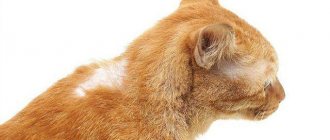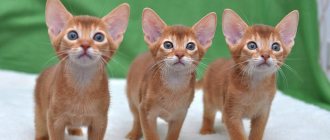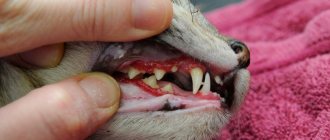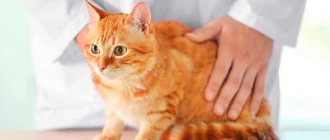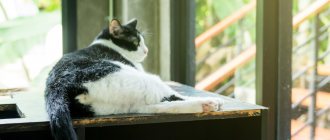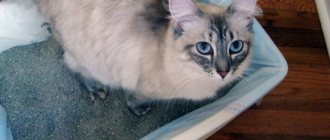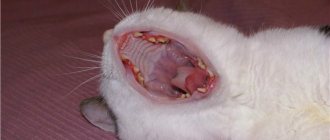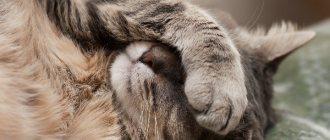Physiological reasons
Physiological factors include natural factors that do not threaten the development of pathologies, for example, pregnancy of an animal. Some of them require the intervention of their owners. The following physiological causes of a large belly in a cat are distinguished:
- pregnancy;
- nervous tension;
- flatulence;
- food poisoning.
Physiological causes of a large belly include pregnancy.
A pet's belly can increase due to muscle tension resulting from pain of any nature, or if the cat itself tenses its muscles, experiencing stress, fearing an attack.
Flatulence in a pet
Gas in a cat is a common occurrence in veterinary practice.
If she passes a small amount of gas 2-4 hours after eating food, this is part of the digestive process and is considered normal. About 90% of the gases released are methane, which has no odor. But if a pet farts more often than usual, and the passage of gas is accompanied by a terrible “amber” and some other signs, this already indicates that he has flatulence. Flatulence in cats is a process of distension and bloating of the abdomen due to the accumulation of gases and air in the stomach or intestines, which the animal swallows while eating food. The unpleasant odor is the result of the release of hydrogen sulfide and other substances, and the release of the resulting excess through the anus is considered a normal physiological phenomenon inherent in all mammals.
Excessive gas production does not mean that a disease is developing in the cat’s body. It is likely that the four-legged pet simply ate food that was unusual for him, and his intestines did not have time to produce enzymes to digest it.
But if flatulence takes a chronic form, this indicates diseases of the gastrointestinal tract. In addition, accumulated gases put pressure on the diaphragm and make breathing difficult. This can cause shock in your pet and even death.
Pathological factors
An enlarged, hard tummy in a cat is observed with the development of a number of serious pathologies. If any abnormalities are detected, you must take your pet to a veterinary clinic. If your pet is thin and has a large belly, you need to monitor him in case he develops symptoms of disease.
We recommend this article:
How to recognize and treat intestinal obstruction in cats
Ascites
This disease is also called abdominal dropsy. Characterized by the accumulation of fluid in the peritoneum. There may be several provoking factors, including disruption of the heart or kidneys. Pathology requires careful diagnosis. Externally, the shape of the abdomen changes when the body position of the four-legged patient changes from saggy to pear-shaped.
Ascites is called abdominal hydrops
Infectious peritonitis
A serious incurable disease caused by coronavirus. Often young individuals are affected. The four-legged patient becomes emaciated, and the abdomen enlarges as fluid accumulates in the peritoneum. The pain syndrome can last for weeks. The disease continues for a month or a year until the animal dies. The main symptom of the disease is bloating.
Pyometra
The pathology affects only cats. The peculiarity of the disease is inflammation and filling of the uterus with pus. If the disease is not diagnosed in time, it continues to progress, and the cat’s abdomen as a whole increases along with the reproductive organ. Treatment involves surgery and complete removal of the uterus. The earlier the disease was identified and eliminated, the greater the chance that the pet will fully recover.
Malignant tumors
If one of the organs of the peritoneum is affected by cancer, then the cat’s abdomen increases along with the growth of the tumor. When palpated, a dense lump is revealed - the tumor itself. In addition to the large tummy, there is asymmetry - one side becomes larger than the other. More often, pathology is detected in older individuals. The lifespan of a pet is difficult to predict.
Obesity
The pathology affects those pets who live in city apartments, lead a sedentary lifestyle and receive poor nutrition, as well as spayed and neutered pets. At the initial stage of development of the disorder, fat is deposited in the groin area and the abdomen sag. If you don't change your cat's lifestyle and diet, obesity will develop. This threatens the pet's death from cardiac obesity.
Table: Determination of the physiological state of the cat
Helminthiasis
All cats are susceptible to infection with worms, even if they do not have access to the street. Helminth infestation is provoked by:
- contaminated food;
- contact with other animals and even insects;
- access to the owner's outdoor shoes.
Even if your pet has regular bowel movements, the peritoneum may be swollen due to the accumulation of parasites inside.
Coprostasis
The pathology is characterized by blockage of the large intestine, due to which there is no bowel movement for several days. Along with the accumulation of feces, the cat's belly grows. Causes of the disease:
- sudden change in food type;
- lack of protein in the diet;
- dehydration;
- binge eating;
- blockage of the intestines with lumps of licked hair;
- defeat by helminths, which accumulate and block the intestinal lumen.
Viral infection
Panleukopenia, or feline distemper, is a dangerous disease that often leads to the death of a pet. Rare pathology. The virus is carried by blood-sucking insects, so even pets that do not have access to the street are not protected from infection.
Treatment Options
If you notice a bloated belly in your kitten, it is best to make an appointment with your veterinarian to rule out the possibility of serious problems. The doctor will conduct a comprehensive examination, refer you to the necessary diagnostic procedures and select the appropriate treatment that will help get rid of the disease.
Treatment of bloating in a pet with medications
At home
What to do if a kitten’s tummy is swollen is a question that concerns all pet owners. Self-treatment for acute and cutting pain is not recommended. It may have unpleasant consequences.
You can use home therapy methods in the early stages of the development of pathology, to alleviate the animal’s condition before going to the doctor. The first step is to remove harmful and fatty foods from your cat’s diet that can irritate the intestines. These include potatoes, corn or dough.
If a small kitten has a bloated stomach and a pain, what should you do to treat the pathology?
- Hilak Forte. The drug is taken 5-6 drops per day, 1 time per day.
- Espumisan for children. The product is also calculated drop by drop, based on the total body weight of the animal. Detailed indicators are presented in the instructions for use.
Important! You should not massage your stomach yourself or do a general massage. This can lead to worsening negative symptoms.
When to go to the vet
If after 1-3 days of self-treatment the animal does not feel better, it is worth seeking medical help to prevent the development of complications.
You should urgently call a doctor in the following cases:
- the kitten has a swollen belly and does not go away within 2 days;
- vomiting and diarrhea do not stop;
- the cat is losing a lot of weight and doesn’t eat anything;
- the pet’s temperature does not drop;
- General syndromes of intoxication and fever appear.
In the above cases, urgent diagnosis is needed to exclude serious pathologies that can become a threat to the cat’s life. To do this, the doctor sends for a blood test, ultrasound or x-ray.
Features of therapy consist of the diagnosis:
- If a cat has a large belly due to intestinal obstruction and stool problems, the drug Duphalac is prescribed. It is used 2-3 times a day. As a supplement, do enemas and drink Vaseline oil 3 times a day.
- Helminthic infestation is treated with specialized antimicrobial drugs, which are selected depending on the age of the pet. The owner must also normalize the cat’s nutrition and monitor its quality of life.
- If bloating occurs as a result of an unbalanced diet, you will need drugs that can stabilize the intestinal microflora. These include “Acipol”, “Lactobacterin”.
Lactobifid for the treatment and prevention of intestinal diseases in cats
To remove waste and toxins in case of renal failure, the use of enterosorbents will be required. For example, “Polysorb”, “Smecta”, activated carbon.
Signs of pathology
A cat's enlarged belly should be the reason for an unscheduled visit to the veterinarian. Sometimes, if the outflow of urine is disrupted or the intestines are blocked, a timely operation can save the life of a pet.
Why do certain pathologies develop if, in the opinion of the owners, the animal is well cared for? The causes of the development of diseases accompanied by enlargement of the peritoneum are:
- poor nutrition, lack of animal access to water;
- non-compliance with the schedule of vaccination and anthelmintic measures;
- peritoneal injuries;
- development of chronic diseases of internal organs.
There are a number of symptoms, the occurrence of which requires urgent consultation with a veterinarian. These include:
- diarrhea;
- vomit;
- apathy;
- increase in body temperature (hot, dry nose and ears);
- lack of appetite;
- the presence of blood, parasites and their eggs in the stool or urine.
When can you not do without a doctor?
If there is any suspicion of health problems, it is advisable to take the kitten to the veterinarian. But there are symptoms in which this must be done without delay.
If, in addition to a swollen belly, the kitten has:
- weakness, apathy;
- refusal to eat;
- increased body temperature;
- vomit;
- repeated diarrhea.
The combination of these signs means there is a high probability that the pet has inflammation of the abdominal cavity (infectious peritonitis), accompanied by bloody discharge or an outpouring of pus.
If the kitten is thin and the belly sticks out a lot, you can do the following - lift the animal, holding it under the front paws and look at the belly. If the bulge falls off, taking the shape of a pear, and returns to its place after the kitten is put on its feet, most likely fluid has accumulated in the abdominal cavity. This disease is called ascites.
Both peritonitis and ascites threaten not only the health, but also the life of the pet. Therefore, you cannot do without an urgent visit to the doctor.
How is diagnosis carried out?
To identify the causes of pathology, a number of diagnostic measures are carried out:
- Lab tests. Examination of feces, urine and blood can reveal infection with parasites and the presence of oncology.
- General inspection. Feeling and listening to the animal's peritoneum helps to correctly identify the cause of the enlargement.
- Ultrasound, radiography. Visualization of the condition of internal organs allows you to accurately determine the disease.
Attempting to diagnose a cat yourself can lead to the death of the pet. The diagnosis is made only after a comprehensive diagnosis. Despite the similarity of symptoms, not all diseases require the same treatment, so seeing a doctor is a must!
General examination Laboratory tests Pet ultrasound
How to determine the cause of a bloated belly
In most cases, an increase in the size of a kitten's belly is not a sign of serious pathologies. You can try to determine the cause of a bloated belly yourself:
- When the problem is related to errors in nutrition, namely overeating or feeding age-inappropriate food, the kitten experiences bloating. This occurs due to pressure on the walls of the intestines and peritoneum of gases that were formed due to malfunctions in the baby’s digestive system. In other words, the kitten is worried about flatulence. It's very easy to check - just lightly tap your stomach with your fingertips. If at the same time a dull sound occurs (as if from a “barrel”), then this indicates flatulence. You can also often feel and hear a rumbling sound when you put your hand on the kitten’s tummy.
Help an animal
Sometimes the owner can provide first aid on his own, but you still need to contact the veterinarian without wasting time.
| Disease | Symptoms | Therapy |
| Coprostasis | Palpation of the abdomen reveals an oblong-shaped compaction | The pet is given an enema and given orally Vaseline oil or a solution of magnesium sulfate |
| Helminthiasis | The appearance of parasites and/or their eggs in stool or vomit | Anti-worm medication with mandatory repeat after 3 weeks |
| Panleukopenia or other virus | Increased body temperature | Diet, antiviral and immunostimulating agents |
| Wet peritonitis | Soft belly | In most cases, the pet is euthanized |
| Ascites | Yellow tint of mucous membranes | Removing fluid from the peritoneum, changing the diet |
Helminthiasis
It is almost impossible to protect a cat from worms. A pet can pick them up through contact with outdoor shoes, from an eaten insect, from raw or undercooked fish or meat. They affect internal organs. Symptoms:
- Bloating.
- Constipation alternating with diarrhea.
- Worms in feces indicate a large number of them in the body.
- Nausea.
- Vomiting with worms.
Treatment consists of using anthelmintic drugs for external and internal use.
Feline distemper, or panleukopenia, is caused by one of the parvoviruses. Summer and late autumn are the most favorable times for the spread of the virus. Its carriers can be blood-sucking insects, ticks and healthy animals.
2–12 days after the virus enters the gastrointestinal tract, it affects the intestinal mucosa, lymphoid tissue and bone marrow.
In animals older than 3 months, the disease causes the following symptoms:
- Body temperature 40–41 degrees.
- Weight loss.
- Refusal to drink despite being thirsty.
- Vomit.
- Diarrhea.
- Bloating.
- Severe abdominal pain.
About a week after the onset of symptoms, the cat has a 50% chance of recovery generally. If the temperature drops to 37–38 degrees, the likelihood of death increases. If a kitten from 1 to 3 months is infected with parvovirus, the probability of death is close to 100%.
When diagnosing panleukopenia, other diseases with similar symptoms should be excluded:
- Poisoning.
- Non-contagious gastroenteritis.
- Lymphosarcoma.
- Toxoplasmosis.
We invite you to read: Ciprolet for cats instructions for use. Ciprovet for cats. It is noted as side effects.
When treating panleukopenia, depending on the nature of the course, the following are used:
- Drugs against the virus.
- Drugs that activate the immune system.
- Drugs that support the functions of the cardiovascular system.
- Antiemetic drugs.
- Broad spectrum antibiotics.
- Drugs that restore electrolyte balance.
- Painkillers and antispasmodics.
During the recovery period, the following diet is necessary:
- Fresh lactic acid products.
- Rice water with the addition of boiled egg white.
- Puree soups from cereals, vegetables with the gradual inclusion of boiled minced meat.
Immunity after illness lasts 3–4 years. Prevention consists of vaccination and hygiene.
Inflammation of the peritoneum with a general serious condition of the body is called. The cause is usually the penetration of infection into the abdominal cavity from the organs. This disease is often caused by a coronavirus. There are 2 forms of coronavirus peritonitis – wet and dry.
The wet form leads to death 1–1.5 months after the onset of symptoms:
- The abdomen is enlarged and soft.
- Fever.
- Lethargy.
- Loss of appetite.
- Weight loss.
The dry form leads to death a year after the onset of the disease. The symptoms are the same as with the wet form, with the exception of an enlarged abdomen. There is no treatment for coronavirus peritonitis; sick animals must be euthanized.
Coronavirus usually enters a cat's digestive tract from the feces of an infected animal. Not all carriers of the virus get sick. Stress can provoke disease in healthy carriers. Most often kittens from 1 to 4 months get sick. Predisposition to the disease is inherited.
Prevention:
- Avoiding stress.
- Avoiding crowding of animals.
- Maintaining hygiene rules.
An animal that has not undergone preventive treatment for more than 3–12 months is guaranteed to be infected with worms. The only question is their number and size. In kittens born on the streets, by the age of one month, severe bloating is observed in the abdomen, due to the active reproduction of parasites that “huddle” into a ball.
In the article I will list the main reasons why a cat has a swollen belly (constipation, gas, disease, etc.). I'll tell you how to help your pet and when you should contact a veterinarian.
Bloat can happen for many reasons, and some of them can be life-threatening for your pet.
A kitten's belly may become bloated due to certain foods. Often, flatulence (accumulation of gases in the intestines) results from feeding your pet milk and dairy products (especially for adult animals).
The cause of bloating may be the high content of carbohydrates in the menu: wheat, corn, etc.
Constipation
- This is an accumulation of feces, and they become dry and hard and cannot pass out on their own. This leads to intoxication of the body, and gases begin to accumulate in the intestines, which cause bloating.
Constipation occurs for many reasons:
- incorrectly composed diet;
- intestinal obstruction;
- accumulation of wool in the stomach;
- congenital anomalies;
- obesity and inactivity.
Severe infestation of a cat with worms is another cause of flatulence or bloating.
Cats that eat very greedily and eat a lot often suffer from flatulence. At the same time, they swallow food without chewing it, which leads to large amounts of air entering the intestines and stomach. As a result, the intestines can swell to incredible sizes. Usually the animals themselves who live in shelters or nurseries eat so greedily.
Enlarged intestines can be a symptom of serious diseases of the internal organs:
- Pyometra. With this disease, pus accumulates in the cat's uterus, which is accompanied by an enlargement of the abdominal cavity. Associated symptoms: depression, fever (not always present), discharge from the loop.
- . An enlarged abdomen or ascites (accumulation of fluid in the abdominal cavity) accompanies the wet form of coronavirus infection (FIP).
- Tumors. The volume of the abdomen may increase significantly due to a malignant tumor in the abdominal cavity.
Bloating can occur with intestinal obstruction. This condition is life-threatening and requires immediate surgical intervention.
Preventive actions
To avoid pathologies accompanied by an enlarged abdomen in a cat, you should adhere to the following rules:
- Provide your pet with proper nutrition. Together with your veterinarian, you can choose a diet that suits the age and health characteristics of the cat. It is important not to overfeed the animal, provide access to clean water, and not feed raw meat or fish.
- Isolate the pet. If your four-legged friend does not have contact with other animals that have access to the street, and with insects that enter through open windows, then the risk of developing infectious diseases and parasites is significantly reduced.
- Use of medications. Even an isolated animal needs to be given dewormers every 3 months and vaccinated according to the cat vaccination schedule.
Proper nutrition is the key to a healthy life for a pet.
If you notice an increase in the size of the cat’s abdomen, you need to monitor your pet to identify additional symptoms and contact a veterinary clinic. It is recommended to palpate and check the animal’s body temperature yourself. Sometimes the owner’s delay can cost the pet’s life.
We recommend this article:
Possible causes, methods of diagnosis and treatment of black feces in cats
Recommended Posts
What to do if your cat has blood in the stool: causes, diagnosis and treatment
A cat scratches its neck: possible causes of itching and methods of treatment
Why castrate a cat: pros and cons of the operation
Possible causes, methods of diagnosis and treatment of black feces in cats
Why does a cat pee with blood and why is it dangerous?
What to do if your Jack Russell Terrier sheds a lot and causes allergies
How to eliminate bloating in cats and kittens
Now let's talk about what to do to eliminate a bloated belly in your pet. The method of eliminating bloating depends on the root cause of this condition:
- If flatulence was caused by poor nutrition, it is necessary to exclude all gas-forming products (primarily milk) from the pet’s diet. You can also give your pet Espumisan, Lactobacterin or Acipol.
- In case of constipation, it is necessary to exclude obstruction. If it is not there, the pet is first given Vaseline oil, and if it does not give an effect, then you can use laxatives (Lactusan, Duphalac, etc.).
- If the bloating was caused by helminths, you should give your pet a drug against these parasites. The following drugs are most effective: Milbemax, Kanikvantel, Prazitel, Drontal. In case of severe infestation, the medicine is given twice, with a break of 10 days.
- If the bloating was caused by overeating or the cat greedily swallowing air while eating, you can first fill the dry food with warm water. It is also recommended to provide your pet with constant access to food (in this case, a strictly daily amount is poured into the bowl per day).
In the event that an enlarged abdomen is the result of diseases of the internal organs, it is necessary to show the pet to a veterinarian.
Treatment of a cat should depend on the diagnosis

